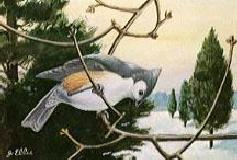
Common Names
Identification
Geography
|
| AREA | STATUS | REFERENCES |
| North America:
Continental United States; Canada |
Yes | Peterson, 1980 |
| Eastern North America:
United States east of Mississippi; Ontario and eastern Canada |
Yes | Peterson, 1980 |
| Southeastern United States:
AL AR DE DC FL GA KY MD NC SC TN VA WV |
Yes | Peterson, 1980 |
| Southern Appalachian States:
AL GA KY MD NC SC TN VA WV |
Yes | Peterson, 1980 |
| Coastal Plain | Yes | Bent, 1964 |
| Piedmont | Yes | Peterson, 1980 |
| Blue Ridge Mountains | Yes | Bent, 1964 |
| Great Smoky Mountains National Park | Yes | Bent, 1964 |
| Ridge and Valley | Yes | Peterson, 1980 |
| Cumberland Plateau | Yes | Peterson, 1980 |
| Central Arch | Yes | Peterson, 1980 |
| Georgia | Yes | Peterson, 1980 |
| Clarke County, Georgia | Yes | UGA Museum of Natural History |
| Sams Farm | Yes | Adeela Farisi, Pers. Ob. |
|
? | - |
|
? | - |
|
Yes | Adeela Farisi, Pers. Ob. |
|
? | - |
| Natural History
Tufted Titmice are non-migratory birds who like to nest in holes or cavities in trees. Their nests vary in size and shape (Bent 1964). Their diet consists of 66% animal matter and 34% vegetable matter. Among their favorites are caterpillars and wasps (Bent 1964). In the winter, titmice eat more berries, nuts, and seeds. They like acorns, hickory nuts, walnuts and pine seeds. They will cling to branches and look in bark crevices for insects. Once in awhile they will forage on the ground (http://www.birdsforever.com/titmouse.html). The titmouse breeding season is between March and May. Nests are anywhere from 3-90 feet above ground. The female builds the nest and the male will bring her food. Males pursue the females and are dominant. These birds form pairs until the death of its partner. Generally they have one brood a year. If they have two, some from the first brood will stay and help the parents (http://www.oit.itd.umich.edu/bio/doc.cgi/Chordata/ Aves/Passeriformes/Paridae/Parus-bicolor.ftl). A brood consists of 4-8 eggs, which are white with brown speckles. The eggs hatch in 13-18 days and after 15-18 days the young leave the nest (http://www.birdsforever.com/titmouse.html). The breeding density is considerably stable and when the population density is low, titmice will lay more eggs. After the breeding season, birds reside in hierarchical flocks. One of the oldest titmice recorded, as of 1983, was 13 years and 3 months; however, this is not common. Life span for a titmouse is 2-3 years (Smith 1991). Location:
|
 Email Addie
Email Addie